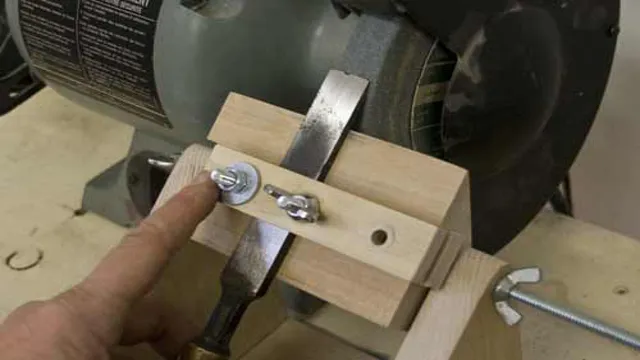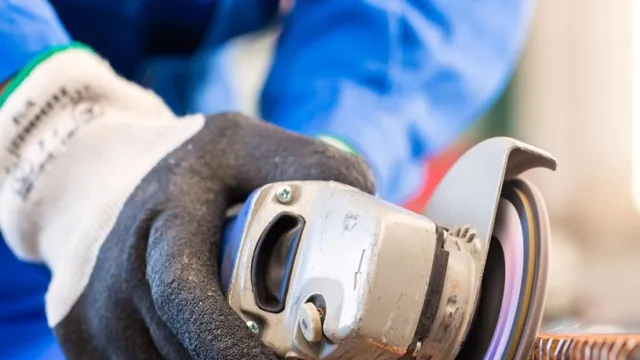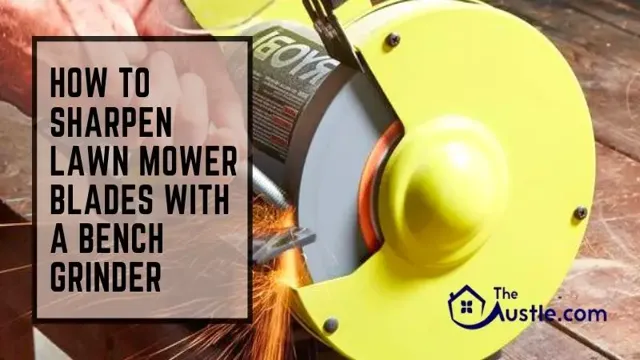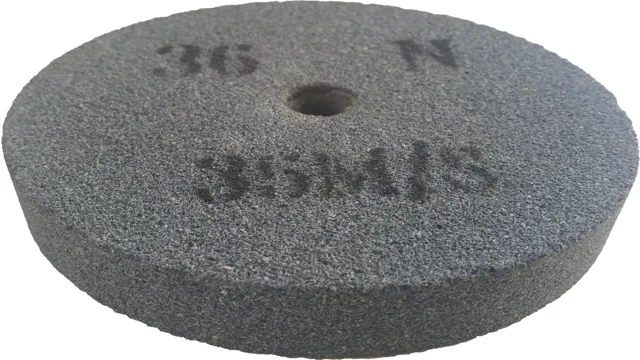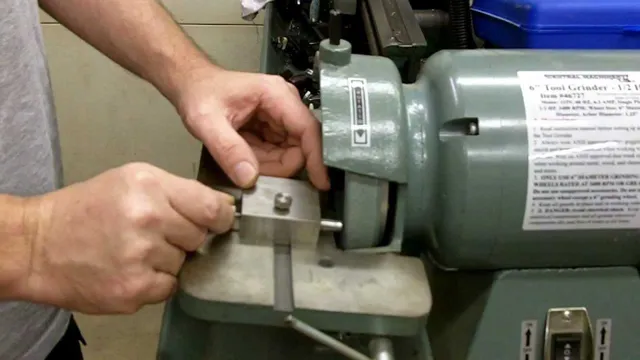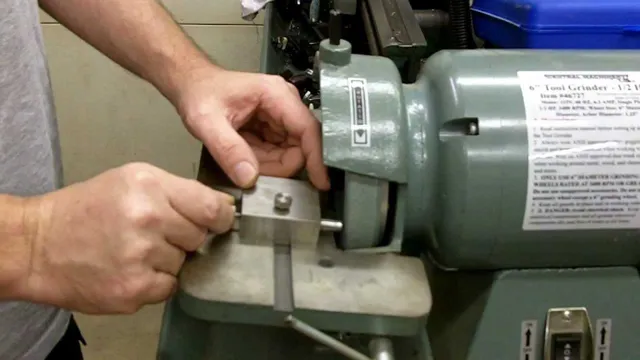Can You Grind Glass with a Bench Grinder? A Comprehensive Guide.
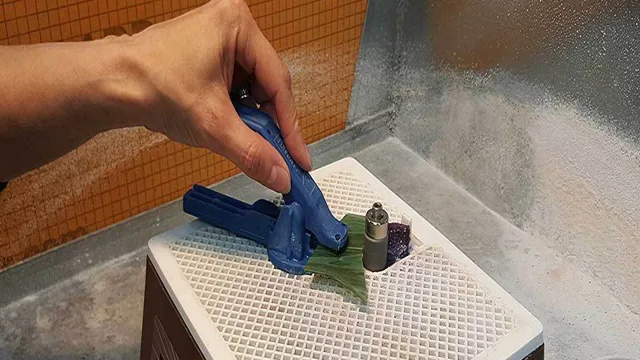
If you’re a DIY enthusiast or professional glassworker, then you know the importance of having a bench grinder in your workspace. This power tool can be used for a variety of tasks, including grinding and shaping glass. However, not everyone knows how to use a bench grinder to grind glass safely and effectively.
So, in this blog post, we’ll take a closer look at the process of grinding glass with a bench grinder and share some tips and tricks to help you get the best results. Whether you’re working on a small or large project, we’ve got you covered. So, let’s dive in and learn more about this essential task!
Understanding Glass Grinding
Yes, you can grind glass with a bench grinder. However, it requires a certain level of expertise and safety precautions to avoid damaging the glass or causing injury. When grinding glass, the hardness and fragility of the material should be considered at all times.
It is recommended to use a diamond bit on the bench grinder to ensure that the glass is ground evenly and smoothly. Additionally, a constant flow of water should be used during the process to keep the glass cool and prevent it from cracking or shattering. It is also important to wear safety equipment such as goggles and gloves to protect yourself from flying glass particles.
While it is possible to grind glass using a bench grinder, it is not necessarily easy and requires careful attention to detail and safety measures.
What is Glass Grinding?
Glass grinding is the process of smoothing and shaping glass objects using abrasive materials such as diamond bits or sandpaper. The goal of glass grinding is to create a flat, even surface on the glass material, removing any rough edges or irregularities. This process is often used in the creation of glass art, such as sculptures or stained-glass windows.
By grinding the glass, artists can create intricate designs with precise edges and details. Glass grinding can also be used in the manufacturing of glass products such as mirrors or lenses. The process requires great skill and precision, as even the slightest mistake can ruin the entire piece of glass.
Overall, glass grinding is an essential part of the glassmaking process that allows artists and manufacturers to create beautiful, functional glass objects.

Why is Glass Grinding Required?
Glass grinding is an essential process used in the manufacturing of glass products. It involves removing any sharp edges or rough surfaces that may have been left behind after cutting or drilling the glass. Glass grinding is also necessary to give the glass a smooth, clear finish that is visually appealing to the eye.
Without proper grinding, the glass would be too dull and unattractive for any practical use. Additionally, it is crucial to ensure that the glass is free from any impurities or deformities that might cause it to weaken and break easily. Therefore, glass grinding is crucial for not only enhancing the appearance of glass but also increasing its strength and durability.
With proper grinding, you can produce high-quality glass products that will stand the test of time.
Can you Grind Glass with a Bench Grinder?
If you’re thinking about grinding glass with a bench grinder, you might want to reconsider. While it is possible to grind glass with a bench grinder, it’s not recommended. It can be a dangerous task, as glass can often shatter or splinter unpredictably when subjected to the high-speed rotations of a bench grinder.
Additionally, a bench grinder is not specifically designed for glass grinding. It can easily overheat, which can lead to cracks and other damage to the glass. If you absolutely have to grind glass, it’s best to use specially designed equipment that is better suited to the task, such as rotary tools or wet belt sanders.
Pros and Cons of Using a Bench Grinder for Glass Grinding
Grinding glass with a bench grinder is a common practice among DIY enthusiasts as it allows them to create unique shapes and designs. However, there are both pros and cons to using this method. On the one hand, bench grinders are efficient and can quickly remove material from the glass, making the process faster.
However, the risk of shattering the glass is high due to the high speed of the grinder. Additionally, the edges of the glass may become chipped, requiring a significant amount of time and effort to repair. On the other hand, specialized equipment such as a diamond grinder can prevent shattering and chipped edges, ensuring a smoother and more precise grinding experience.
Therefore, it is important to weigh the pros and cons of using a bench grinder for glass grinding and make an informed decision based on your needs and preferences.
Factors to Consider Before Grinding Glass with a Bench Grinder
Grinding glass with a bench grinder can be a tricky task, as it requires careful consideration of important factors to ensure a successful outcome. Yes, it is possible to grind glass with a bench grinder, but only if you use the right type of wheels and take proper safety precautions. Firstly, you need to select a suitable wheel for grinding glass, such as a diamond cup wheel or a silicon carbide grinding wheel.
These wheels are designed specifically for grinding hard materials, including glass. Secondly, it is important to wear proper protective gear, including safety glasses and gloves, to prevent injury from glass shards. Additionally, grinding glass requires a steady hand and a proper grip on the glass surface to avoid damaging it.
Lastly, you need to make sure your bench grinder is running at a slow speed to minimize the risk of shattering the glass. As long as you follow these guidelines, you can successfully grind glass with a bench grinder. Remember, safety first!
Recommended Bench Grinder Wheel for Glass Grinding
Yes, you can grind glass with a bench grinder, but you need to use a specific type of wheel. Regular bench grinder wheels are not suitable for glass grinding as they can chip or break the glass due to their roughness. For glass grinding, you need a silicon carbide (also known as carborundum) wheel, which is specifically designed for grinding glass.
This type of wheel has finer grit and smoother edges that allow for precise and smooth grinding without damaging the glass. Additionally, using water during the grinding process can help lubricate the wheel and prevent overheating, which can cause the glass to crack. So, if you plan on grinding glass with a bench grinder, make sure to use a silicon carbide wheel and keep it lubricated with water to achieve the best results.
Step by Step Guide to Grinding Glass with a Bench Grinder
If you’ve ever wondered “can you grind glass with a bench grinder?”, the answer is yes! However, it’s important to note that grinding glass can be a tricky task that requires patience. Here’s a step-by-step guide on how to do it: Choose the right type of bench grinder wheel for the job – a diamond or silicon carbide grinding wheel is best for glass grinding.
Set up your workspace by placing a towel or something similar under the glass to prevent it from slipping or cracking.
Begin by using a coarser grit to grind the glass – this will help to remove any imperfections and shape the glass. Once you’ve achieved the desired shape, switch to a finer grit and continue grinding until the glass is smooth and shiny.
Finally, wash the glass with soap and water to remove any debris or dust. Grinding glass with a bench grinder can be a bit of a learning curve, but with practice and these easy steps, it can be done successfully.
Remember to take your time and be patient to yield the best results, and always wear proper safety gear like gloves, eye protection, and a mask.
Step 1: Safety Precautions
When it comes to grinding glass with a bench grinder, the first and most important step is to prioritize safety. This means wearing appropriate protective gear such as safety glasses, gloves, and a dust mask to prevent any potential harm that may be caused by grinding. Additionally, make sure that the bench grinder is properly secured to a stable surface before use.
It’s also essential to familiarize yourself with the grinder’s controls and safety features. Remember to always follow the manufacturer’s guidelines and recommendations for safe usage. Grinding glass can be a challenging task, but taking all necessary safety measures will ensure a successful and safe outcome.
By doing so, you can enjoy the satisfaction of creating a smooth and polished finish on your glass projects.
Step 2: Set Up the Bench Grinder
Now that you have all the necessary safety gear, it’s time to set up your bench grinder. The first thing you want to do is mount your grinder securely to a workbench or table. You can use clamps or bolts to keep it in place, ensuring it doesn’t wobble or move while you’re working.
Once it’s secured, make sure the grinding wheels are the correct size and material for the glass you’re working with. The wrong wheel can cause damage or breakage, so it’s essential to get this right. Next, adjust the tool rests so they’re close to the wheels but not touching them.
This will ensure you have the right angle and distance to grind the glass effectively. Finally, turn on the grinder and let it run for a few minutes to make sure everything is working correctly. With your bench grinder set up, you’re ready to move on to the next step: preparing the glass.
Step 3: Prepare the Glass for Grinding
After gathering all the necessary tools and materials for grinding glass, the next step is to prepare the glass for grinding. This step is important as it ensures that the glass is ready for the grinding process. To do this, you can start by marking the area to be ground with a permanent marker.
This will help you keep track of the area you want to grind and avoid accidentally grinding the wrong part of the glass. Next, clean the surface of the glass with a soft cloth to remove any dirt or debris that may be present. Make sure the glass is dry before proceeding to the next step.
Finally, attach the glass to the bench grinder with a clamp. Ensure that the clamp is tight enough to hold the glass securely in place but not too tight as to crack the glass. When everything is set up, you are ready to begin grinding the glass.
Remember to wear safety glasses and work slowly and carefully to avoid damaging the glass. With these steps, you can prepare the glass for grinding and achieve the desired result.
Step 4: Begin Grinding the Glass
Glass grinding can seem daunting, but with the right tools and techniques, it can be a straightforward process. Once you have all your safety equipment in place, it’s time to begin grinding. First, turn on your bench grinder and adjust the tool rest to the desired angle.
Next, take the piece of glass you want to grind and hold it firmly against the wheel. Move the glass back and forth along the wheel, making sure to keep it at the same angle. As you grind, you’ll notice that the edges start to become smoother and more polished.
Remember to take breaks frequently to check your progress and adjust your technique as needed. With patience and practice, you’ll become an expert at grinding glass in no time. Overall, grinding glass with a bench grinder is a simple process that requires attention to detail and a steady hand.
Step 5: Finishing Up
For the final step of grinding glass with a bench grinder, it’s essential to give your work a final polish. You can achieve this by using a polishing wheel or pad, moving it slowly and methodically across the glass surface until you have a completely polished finish. It’s important to take your time during this step to ensure a perfect finish without any scratches or rough spots.
Remember to reapply water periodically to keep the glass and polishing material lubricated and cool. Using a final polishing compound can help achieve an even more polished finish. It’s always a good idea to inspect the glass carefully when you’re finished to ensure you’re satisfied with the results.
Congratulations, you’ve successfully grinded and polished glass with a bench grinder!
Conclusion
To put it bluntly, trying to grind glass with a bench grinder is like asking a chicken to fly a plane. Sure, it might be entertaining to watch, but ultimately it is not the right tool for the job. Glass is too delicate and prone to cracking under the intense pressure and rough surface of a bench grinder.
So unless you’re a real glutton for punishment (or have a very warped sense of humor), save yourself the trouble and invest in a proper glass grinding tool instead.”
FAQs
Is it safe to grind glass with a bench grinder?
No, it is not safe to grind glass with a bench grinder because it can cause the glass to shatter and potentially cause injury.
What type of grinder should I use to grind glass?
A diamond grinder or lapidary grinder is recommended for grinding glass because they are designed to handle the delicate material.
Can a bench grinder be used for other materials besides glass?
Yes, a bench grinder can be used for various materials like metal, wood, and plastic, but it is important to use the appropriate grinding wheel for each material.
What safety gear should I wear when using a grinder?
When using a grinder, it is recommended to wear safety glasses, a dust mask, and gloves to protect against flying debris and dust.
What precautions should I take when using a grinder?
Before using a grinder, make sure the grinding wheel is properly installed and secured. Also, ensure the workpiece is held securely in place and the grinder is turned off before adjusting any parts.
Can a bench grinder be used for polishing glass?
No, a bench grinder is not designed for polishing glass. A polishing wheel or buffer is recommended for polishing glass to achieve a smooth, shiny surface.
Is it necessary to use water while grinding glass with a diamond grinder?
Yes, it is recommended to use water while grinding glass with a diamond grinder to keep the glass cool and prevent it from cracking or shattering.

